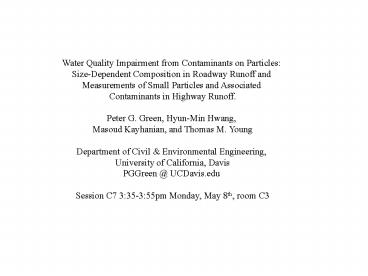Water Quality Impairment from Contaminants on Particles: - PowerPoint PPT Presentation
1 / 20
Title:
Water Quality Impairment from Contaminants on Particles:
Description:
Water Quality Impairment from Contaminants on Particles: Size-Dependent ... Note very high level of Cd on brakes due to anti-squeak coating! ... – PowerPoint PPT presentation
Number of Views:32
Avg rating:3.0/5.0
Title: Water Quality Impairment from Contaminants on Particles:
1
Water Quality Impairment from Contaminants on
Particles Size-Dependent Composition in Roadway
Runoff and Measurements of Small Particles and
Associated Contaminants in Highway
Runoff. Peter G. Green, Hyun-Min Hwang, Masoud
Kayhanian, and Thomas M. Young Department of
Civil Environmental Engineering, University of
California, Davis PGGreen _at_ UCDavis.edu Session
C7 335-355pm Monday, May 8th, room C3
2
Abstract Small particles critically affect
water quality. Besides reducing water clarity,
sparingly soluble pollutants such as polycyclic
aromatic hydrocarbons (PAHs) and some heavy
metals are predominantly transported on
particles. We have conducted a series of
studies on non-point-source (NPS) roadway-derived
fine particles, defined here as lt63um
traditionally the upper limit of silt and a
size range which is readily suspended in moving
water and which settles slowly. At the finest,
we have examined the elemental composition of
particles in the size range of 0.1 to 0.3um,
commonly considered colloidal that is,
non-settling. (Importantly, these also readily
pass through filters of 0.45um or larger
pore-size.) In addition we have begun
characterizing the sources of particles and
particle-bound pollutants, and studied the
solubilization of metals by dissolved organic
matter.
3
Locations of studies
Arcade Creek
I-80 Vacaville
Davis I-80
Fairfield Maintenance Yard
Interstate 680
Interstate 880
(Also 3 sites near UCLA US-101 2 on I-405)
Calif. Highway 91 in Corona
4
Monitoring of CTR Pollutants in Stormwater Runoff
Collected at Caltrans Facilities
5
(No Transcript)
6
Concentrations typically highest at beginning of
rainy season, but also quite high later
following long dry periods. (I-80 Vacaville)
7
Concentrations typically highest at beginning of
rainy season, but also quite high later such as
during small storms. (I-80 Davis)
8
Abundant Fine Particles in Highway Runoff
9
Methods
- Filtration in field, during storms
- Stokes-law settling in lab, same day
- Flow cytometry particle sorting
- (by light scattering)
- Particle counts by light-scattering (Liquilaz) in
lab and at highway road-side - Ultrafiltration (1kDa cut-off, 1nm)
- Analysis by GC-MS and ICP-MS
10
Particle Sorter Schematic (DykoCytomation MoFlo
Cell Sorter )
11
Fraction of total particle mass in sub-micron
size range. Note clear trend in Pb.
12
Cumulative Elemental Composition of Particles in
Highway Storm-water
13
Distribution of PAHs in 2um to 63um Size-Classes
of Particles in Highway Stormwater
14
PAHs on colloidal particles
gt90 of heaviest PAHs which filter are not
actually dissolved.
15
Note very high level of Cd on brakes due to
anti-squeak coating! (Fractional composition out
of 21 element total.)
16
Dissolved organic matter solubilizes copper.
Lee Read M.S. Thesis Figure 1. The influence of
DOC on copper (Cu) desorption (Lu and
Young, unpublished)
17
Time scale of metal solubilization. (H.L.Read,
M.S. thesis 2005)
70
10
Cu
Zn
9
Ni
Pb
60
8
50
7
6
40
Dissolved Cu and Zn Concentrations
(ppb)
Dissolved Ni and Pb Concentrations
(ppb)
5
30
4
3
20
2
10
1
0
0
0
10
20
30
40
50
60
Time (hours)
Figure 2. Metal desorption from particles in
contact with constant DOC concentration over
time, DOC 19.2 mg/L
18
Initial mobilization of Cu
100.0
90.0
80.0
70.0
60.0
DOC(mg/L)
50.0
pH(6.8 to 7.2)
Cu( F/UF)
40.0
30.0
20.0
10.0
0.0
1
2
3
4
5
6
Progression through storm
19
Conclusions Several different approaches have
successfully begun to characterize with
size-dependent detail the elemental and organic
composition of non-point source pollution from
highway and urban run-off, as well as directly
from vehicles. For PAHs (especially heavier
PAHs) dramatic water quality improvements are
only achieved where all but the finest (1um)
particles are removed. For heavy metals,
continuous improvement in water quality is seen
as ever smaller particles are removed all the
way into the colloidal (lt0.5um) range.
20
Acknowledgements We gratefully acknowledge
support from Caltrans, University California
Toxics Research and Training Program, and the
EPA Superfund Basic Research program. Data has
kindly been shared by graduate students Carol
Wong, Daekyun Kim, Jon Money and Lee
Read. On-going collaboration with Prof. Mike
Stenstrom, UCLA, with post-doc Sim-Lin Lau and
other group members.































